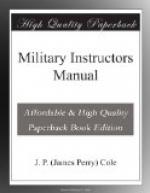a. After having received his
orders, the regimental commander
leads his regiment forward in a column, or in
line of columns,
until the time arrives for issuing the regimental
order, he
then: (426, i.d.r.)
b. Assigns targets and sectors or tasks to
battalions and special
units. (312, 381 and 426, i.d.r.)
c. Provides for necessary reconnaissance to
front and flank. (428,
i.d.r.)
d. Announces his position and also that of
the next higher
commander.
e. Controls the reserve as the tactical situation
demands. (441,
i.d.r.)
f. Regulates ammunition supply. (316, f.s.r.
and 552, i.d.r.) See
also full discussion of the ammunition supply
in Subject VIII.
Note—The colonel is assisted in the performance of his duties by the regimental staff.
II. THE MAJOR.
The battalion is the attack unit whether acting alone or as part of a larger force. (305, i.d.r.)
POSITION:
(The general rules for a colonel apply)
1. Where he can best:
a. Direct the reinforcing of the firing
line from the
support. (315, i.d.r.)
b. Observe the progress of events, (369,
i.d.r.)
c. Maintain contact with regimental headquarters.
(369,
i.d.r.)
2. On the firing line when
all the supports have joined. (315,
i.d.r.) (See Subject V.)
GENERAL.
DUTIES:
1. Conducts his battalion according
to sector and mission assigned
him.
2. Directs first disposition of battalion
by tactical orders,
giving subordinates—
a. Information of the enemy.
b. Position of supporting and neighboring
troops.
c. The general object to be attained.
d. The special problem for each company
(291, i.d.r.)
(This includes making the primary apportionment
of the
target.) (303, i.d.r.)
e. If practicable, the point or time
at which the fire fight
is to open. (304, i.d.r.)
f. Orders for flank protection and reconnaissance,
unless
specifically provided for by higher authority.
(293, 397
and 398, i.d.r.)
g. His position and that of the next
higher commander.
3. Controls supports, dispatches reinforcements
from support to
firing line. (226 and 297, i.d.r.)
4. Controls subsequent movements by suitable
orders or commands.
(291, i.d.r.)
5. Regulates ammunition supply—(See
Subject VIII, also Pars.
316-317, f.s.r.) (The combat train is the immediate
reserve
supply of the battalion.)
a. Is responsible for the proper use
of the combat train.
b. Insures maintenance of the prescribed
allowance at all
times.
c. Causes combat trains to march immediately
in rear of the
battalion unless directed otherwise. (548,
i.d.r.)
d. When battalion deployed on his own
initiative, indicates
whether extra ammunition shall be issued.
(294, i.d.r.)
e. When battalion deployed pursuant to




